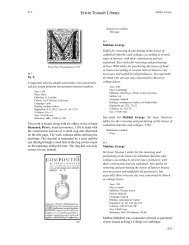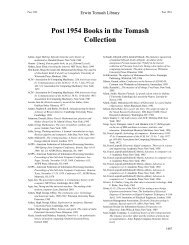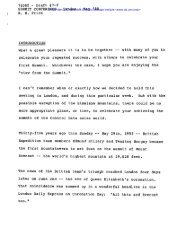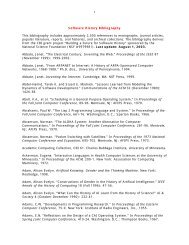B chapter.indd - Charles Babbage Institute - University of Minnesota
B chapter.indd - Charles Babbage Institute - University of Minnesota
B chapter.indd - Charles Babbage Institute - University of Minnesota
Create successful ePaper yourself
Turn your PDF publications into a flip-book with our unique Google optimized e-Paper software.
176<br />
Erwin Tomash Library<br />
Borda, Jean <strong>Charles</strong> de Borghi, Pietro<br />
serial and parallel machine architecture and a description<br />
<strong>of</strong> the operation code for the Booth ARC (Automatic<br />
Relay Computer).<br />
It should be noted that this paper was written (but not<br />
published) before an operating stored program computer<br />
existed.<br />
Illustrations available:<br />
ARC instruction set.<br />
B 207<br />
Borda, Jean <strong>Charles</strong> de (1733–1799)<br />
Tables trigonométriques décimales, ou table des<br />
logarithmes des sinus, sécantes et tangentes, suivant<br />
la division du quart de cercle en 100 degrés, du degré<br />
en 100 minutes, et de la minute en 100 secondes.<br />
Précédées de la table des logarithmes des nombres<br />
depuis dix mille jusqu’à cent mille, et de plusiers tables<br />
subsidiares.<br />
Year: 1801<br />
Place: Paris<br />
Publisher: Imprimerie de la République<br />
Edition: 1st<br />
Language: French<br />
Binding: quarter bound leather, marbled boards<br />
Pagination: pp. [4],120, [510]<br />
Collation: π 2 a–p 4 a–2d 4 2e 2 A–2N 4 2O 1<br />
Size: 237x187 mm<br />
Reference: Glais RCMT, pp. 88–89; Kno NTMV, p. 71<br />
Borda was a major figure in the French Navy who<br />
participated in several scientific voyages and in the<br />
American Revolution. He was a member <strong>of</strong> the group<br />
B 207<br />
responsible for measuring the length <strong>of</strong> the meridional<br />
arc from the North Pole to the equator and thus was<br />
active in establishing the metric system. He attained<br />
the rank <strong>of</strong> Capitaine de Vaisseau and was appointed as<br />
inspector <strong>of</strong> the French naval academy in 1784. Borda<br />
was taken prisoner by the British during a naval action<br />
in the Antilles in 1782; thereafter his health suffered<br />
to the point where he was unable to take up his former<br />
sea duties. His main contributions were to the design <strong>of</strong><br />
ships and in studies showing Newton was incorrect in his<br />
theory <strong>of</strong> fluid flow. He invented a surveying instrument<br />
(circle de réflexion), and these tables may well have<br />
begun as an adjunct to its use.<br />
This is the first publication <strong>of</strong> a table <strong>of</strong> logarithms <strong>of</strong><br />
trigonometric functions calculated according to the one<br />
hundred-degree division <strong>of</strong> the quadrant that was initially<br />
proposed for the metric system. The tables have entries<br />
for each degree, minute and second <strong>of</strong> this division<br />
scheme. It contains two prefaces, the first <strong>of</strong> 38 pages<br />
by Borda and the second <strong>of</strong> 76 pages by Delambre, who<br />
saw the work through the press after Borda died.<br />
Illustrations available:<br />
Title page<br />
Tape <strong>of</strong> the tables<br />
B 208<br />
Borghi, Pietro (–1494)<br />
Qui comenza la nobel opera de arithmethica ne la<br />
qual se tracta tute cosse amercantia pertinente facta e<br />
compilata p[er] Piero Borgi da veniesia.<br />
First page: SDSU Chi d’arte mathematice ha paicere<br />
… [17 line sonnet]<br />
Year: 1484<br />
Place: Venice<br />
Publisher: Erhard Ratdolt<br />
Edition: 1st<br />
Language: Italian<br />
Binding: later limp vellum<br />
Pagination: ff. [1], 116, [1] (misnumbered 22 as 32, 23 as 32,<br />
102 as 103)<br />
Collation: π 8 b–o 8 p 6<br />
Size: 202x152 mm<br />
Reference: Smi Rara, pp. 16-18<br />
Pietro Borghi (Piero Borgi) was a Venetian who died<br />
sometime after 1494, but nothing more is known <strong>of</strong> his<br />
life.<br />
This is an important book in the history <strong>of</strong> arithmetic.<br />
It is the second arithmetic book printed in Italy (after<br />
the Treviso arithmetic). The description done by Smith<br />
(Rara) cannot be bettered, and what follows is drawn<br />
freely from that source.







